Numerical Simulation-Based Analysis of Seafloor Hydrothermal Plumes: A Case Study of the Wocan-1 Hydrothermal Field, Carlsberg Ridge, Northwest Indian Ocean
Abstract
1. Introduction
2. Methods
2.1. Numerical Simulation Method and Model
2.2. Parameter Settings of the Numerical Model
3. Results
3.1. Plume Structure
3.2. Velocity Field of Hydrothermal Plumes
3.3. Temperature Field of Hydrothermal Plumes
4. Discussion
4.1. Relationship between Plume Height and Background Current Velocity
4.2. Reconstruction of Background Current Velocity
4.3. Transport Pattern of Plume Particles and the Controlling Factors
5. Conclusions
- In this study, we build a three-dimensional numerical model of a submarine hydrothermal plume using the field observation data collected in the Wocan-1 Hydrothermal field. The results lead to the following conclusions: The structure of the plume consists of a cone-shaped rising zone, columnar-shaped rising zone, and neutral-buoyancy layer. Background ocean current alters the structure of the plume, causing its bending and increasing of diffusion capacity. The bending angle of the plume axis is positively correlated with the background current velocity. The plume structure would damage when the current velocity would be larger than 10 cm/s.
- An increase in background current velocity significantly reduces the maximum rise height and a neutral-buoyancy layer height of the plume. Two empirical formulas are established to describe the Wocan-1 hydrothermal plume: the maximum rise height Zmax = 315.1 – 1.252v + 0.4v2 – 0.162v3, and the neutral-buoyancy layer height Zneutral = 255 – 0.016v + 0.245v2 – 0.112v3.
- Using the temperature anomaly profile obtained by on-site CTD measurement near the flaming hill of WHF-1, by fitting the temperature profile extracted from our numerical model, the background current velocity of 10 cm/s is reconstructed, which is within the dominant range of ocean current velocities registered by the long-term observational mooring system deployed near the WHF-1. This also attests to the robustness of our model.
- Under the background current velocity of 10 cm/s, the pyrite grains smaller than 2 mm can be transported over 1 km by the high-temperature black smokers from the flaming hill of WHF-1, those between 3 mm and 5 mm would deposit within 137–240 m from the venting site, while particles larger than 10 mm cannot be transported with the plume and deposit near the venting site.
Author Contributions
Funding
Institutional Review Board Statement
Informed Consent Statement
Data Availability Statement
Acknowledgments
Conflicts of Interest
References
- Corliss, J.B.; Dymond, J.; Gordon, L.I.; Edmond, J.M.; von Herzen, R.P.; Ballard, R.D.; Green, K.; Williams, D.; Bainbridge, A.; Crane, K.; et al. Submarine thermal springs on the Galapagos Rift. Science 1979, 203, 1073–1083. [Google Scholar] [CrossRef] [PubMed]
- Beaulieu, S.E.; Baker, E.T.; German, C.R.; Maffei, A. An authoritative global database for active submarine hydrothermal vent fields. Geochem. Geophys. Geosystems 2013, 14, 4892–4905. [Google Scholar] [CrossRef]
- Baker, E.T.; Massoth, G.J. Characteristics of hydrothermal plumes from two vent fields on the Juan de Fuca Ridge, northeast Pacific Ocean. Earth Planet. Sci. Lett. 1987, 85, 59–73. [Google Scholar] [CrossRef]
- Bemis, K.; Lowell, R.P.; Farough, A. Diffuse flow: On and around hydrothermal vents at Mid-Ocean Ridges. Oceanography 2012, 25, 182–191. [Google Scholar] [CrossRef]
- Baker, E.T. Hydrothermal plumes. In Encyclopedia of Marine Geosciences; Springer: Berlin/Heidelberg, Germany, 2014. [Google Scholar] [CrossRef]
- German, C.R.; Seyfried, W.E. Hydrothermal Processes. In Treatise on Geochemistry; Elsevier: Amsterdam, The Netherlands, 2014; Volume 8, pp. 191–233. [Google Scholar]
- Haymon, R.M. Growth history of hydrothermal black smoker chimneys. Nature 1983, 301, 695–698. [Google Scholar] [CrossRef]
- Gartman, A.; Findlay, A.J. Impacts of hydrothermal plume processes on oceanic metal cycles and transport. Nat. Geosci. 2020, 13, 396–402. [Google Scholar] [CrossRef]
- Sudarikov, S.; Narkevsky, E.; Petrov, V. Identification of two new hydrothermal fields and sulfide deposits on the Mid-Atlantic Ridge as a result of the combined use of exploration methods: Methane detection, water column chemistry, ore sample analysis, and camera surveys. Minerals 2021, 11, 726. [Google Scholar] [CrossRef]
- Zeng, Z.; Wang, X.; Murton, B.J.; Qi, H.; Lehrmann, B.; Li, X.; Shu, Y. Dispersion and intersection of hydrothermal plumes in the Manus back-arc basin, western pacific. Geofluids 2020, 2020, 4260806. [Google Scholar] [CrossRef]
- Kim, J.; Son, S.K.; Kim, D.; Pak, S.J.; Yu, O.H.; Walker, S.L.; Son, J. Discovery of active hydrothermal vent fields along the Central Indian Ridge, 8–12 S. Geochem. Geophys. Geosystems 2020, 21, e2020GC009058. [Google Scholar] [CrossRef]
- De Ronde, C.E.J.; Baker, E.T.; Massoth, G.J.; Lupton, J.E.; Wright, I.C.; Sparks, R.J. Submarine hydrothermal activity along the mid-Kermadec Arc, New Zealand: Large-scale effects on venting. Geochem. Geophys. Geosystems 2007, 8. [Google Scholar] [CrossRef]
- Morton, B.R.; Taylor, G.I.; Turner, J.S. Turbulent gravitational convection from maintained and instantaneous sources. Proc. R. Soc. London. Ser. A Math. Phys. Sci. 1956, 234, 1–23. [Google Scholar]
- Lavelle, J.W. A convection model for hydrothermal plumes in a cross flow. NOAA 1994, 102, 1–18. [Google Scholar]
- Tao, Y.; Rosswog, S.; Brüggen, M. A simulation modeling approach to hydrothermal plumes and its comparison to analytical models. Ocean. Model. 2013, 61, 68–80. [Google Scholar] [CrossRef]
- Lou, Y.; He, Z.; Jiang, H.; Han, X. Numerical simulation of two coalescing turbulent forced plumes in linearly stratified fluids. Phys. Fluids 2019, 31, 037111. [Google Scholar]
- Jiang, H.; Breier, J.A. Physical controls on mixing and transport within rising submarine hydrothermal plumes: A numerical simulation study. Deep. Sea Res. Part I Oceanogr. Res. Pap. 2014, 92, 41–55. [Google Scholar] [CrossRef]
- Adams, I.; Di Iorio, D. Turbulence Properties of a Deep-Sea Hydrothermal Plume in a Time-Variable Cross-Flow: Field and Model Comparisons for Dante in the Main Endeavour Field. J. Geophys. Res. Ocean. 2021, 126, e2020JC016638. [Google Scholar] [CrossRef]
- Lou, Y.; Han, X.; He, Z.; Wang, Y.; Qiu, Z. Numerical modeling of hydrodynamic processes of deep-sea hydrothermal plumes: A case study on Daxi hydrothermal field, Carlsberg Ridge. Sci. Sin. Tech. 2020, 50, 194–208. (In Chinese) [Google Scholar]
- Lou, Y.; He, Z.; Han, X. Transport and deposition patterns of particles laden by rising submarine hydrothermal plumes. Geophys. Res. Lett. 2020, 47, e2020GL089935. [Google Scholar] [CrossRef]
- Jamieson, J.W.; Gartman, A. Defining active, inactive, and extinct seafloor massive sulfide deposits. Mar. Policy 2020, 117, 103926. [Google Scholar] [CrossRef]
- Qiu, Z.; Han, X.; Li, M.; Wang, Y.; Chen, X.; Fan, W.; Zhou, Y.; Cui, R.; Wang, L. The temporal variability of hydrothermal activity of Wocan hydrothermal field, Carlsberg Ridge, northwest Indian Ocean. Ore Geol. Rev. 2021, 132, 103999. [Google Scholar] [CrossRef]
- Wang, Y.; Han, X.; Petersen, S.; Frische, M.; Qiu, Z.; Li, H.; Li, H.; Wu, Z.; Cui, R. Mineralogy and trace element geochemistry of sulfide minerals from the Wocan Hydrothermal Field on the slow-spreading Carlsberg Ridge, Indian Ocean. Ore Geol. Rev. 2017, 84, 1–19. [Google Scholar] [CrossRef]
- Xie, Q.; Han, X.; Wei, M.; Qiu, Z.; Dong, C.; Wu, Y.; Wu, X.; Yu, J. Characteristics and evolution of bacterial communities in the Wocan hydrothermal plume-influenced zone, Carlsberg Ridge, northwestern Indian Ocean. Acta Microbiol. Sin. 2022, 62, 1974–1985. (In Chinese) [Google Scholar]
- Cai, Y. Characteristics of Hydrothermal Activity and Sulfide Minerals of Wocan-1 Hydrothermal Field, Carlsberg Ridge. Master’s Thesis, Second Institute of Oceanography, MNR, Zhejiang, China, 2020. (In Chinese). [Google Scholar]
- Rodi, W. Experience with Two-Layer Models Combining the k-e Model with A One-Equation Model Near the Wall. In Proceedings of the 29th Aerospace Sciences Meeting, Reno, NV, USA, 7–10 January 1991. [Google Scholar]
- Shih, T.H.; Liou, W.W.; Shabbir, A.; Yang, Z.; Zhu, J. A new k-ϵ eddy viscosity model for high reynolds number turbulent flows. Comput. Fluids 1995, 24, 227–238. [Google Scholar] [CrossRef]
- Crowe, C.T.; Schwarzkopf, J.D.; Sommerfeld, M.; Tsuji, Y. Multiphase Flows with Droplets and Particles; CRC Press: Boca Raton, FL, USA, 2011. [Google Scholar]
- Chen, Y.; Lou, Y.; He, Z.; Wang, Y. Flow fields and outputs of the hydrothermal plume at the Wocan-1 field based on an in-situ video. Sci. Sin. Tech. 2022, 52, 1705–1715. (In Chinese) [Google Scholar] [CrossRef]
- Han, X.; Wang, Y.; Wu, Z. Survey Report for the Second Stage of DY 57; Second Institute of Oceanography, MNR: Zhejiang, China, 2019. (In Chinese) [Google Scholar]
- German, C.R.; Briem, J.; Chin, C.; Danielsen, M.; Holland, S.; James, R.; Jónsdóttir, A.; Ludford, E.; Moser, C.; Ólafsson, J.; et al. Hydrothermal activity on the Reykjanes Ridge: The Steinahóll vent-field at 63 06′ N. Earth Planet. Sci. Lett. 1994, 121, 647–654. [Google Scholar] [CrossRef]
- Baker, E.T.; Lavelle, J.W. The effect of particle size on the light attenuation coefficient of natural suspensions. J. Geophys. Res. Ocean. 1984, 89, 8197–8203. [Google Scholar] [CrossRef]
- Feely, R.A.; Massoth, G.J.; Trefry, J.H.; Baker, E.T.; Paulson, A.J.; Lebon, G.T. Composition and sedimentation of hydrothermal plume particles from North Cleft segment, Juan de Fuca Ridge. J. Geophys. Res. Solid Earth 1994, 99, 4985–5006. [Google Scholar] [CrossRef]
- Popoola, S.O.; Han, X.; Wang, Y.; Qiu, Z.; Ye, Y. Geochemical investigations of Fe-Si-Mn oxyhydroxides deposits in wocan hydrothermal field on the slow-spreading carlsberg ridge, Indian Ocean: Constraints on their types and origin. Minerals 2018, 9, 19. [Google Scholar] [CrossRef]
- Popoola, S.O.; Han, X.; Wang, Y.; Qiu, Z.; Ye, Y.; Cai, Y. Mineralogical and geochemical signatures of metalliferous sediments in Wocan-1 and Wocan-2 hydrothermal sites on the Carlsberg Ridge, Indian Ocean. Minerals 2019, 9, 26. [Google Scholar] [CrossRef]
- Breier, J.A.; Toner, B.M.; Fakra, S.C.; Marcus, M.A.; White, S.N.; Thurnherr, A.M.; German, C.R. Sulfur, sulfides, oxides and organic matter aggregated in submarine hydrothermal plumes at 9°50′ N East Pacific rise. Geochim. Et Cosmochim. Acta 2012, 88, 216–236. [Google Scholar] [CrossRef]
- Walker, S.L.; Baker, E.T.; Resing, J.A.; Chadwick Jr, W.W.; Lebon, G.T.; Lupton, J.E.; Merle, S.G. Eruption-fed particle plumes and volcaniclastic deposits at a submarine volcano: NW Rota-1, Mariana Arc. J. Geophys. Res. Solid Earth 2008, 113. [Google Scholar] [CrossRef]
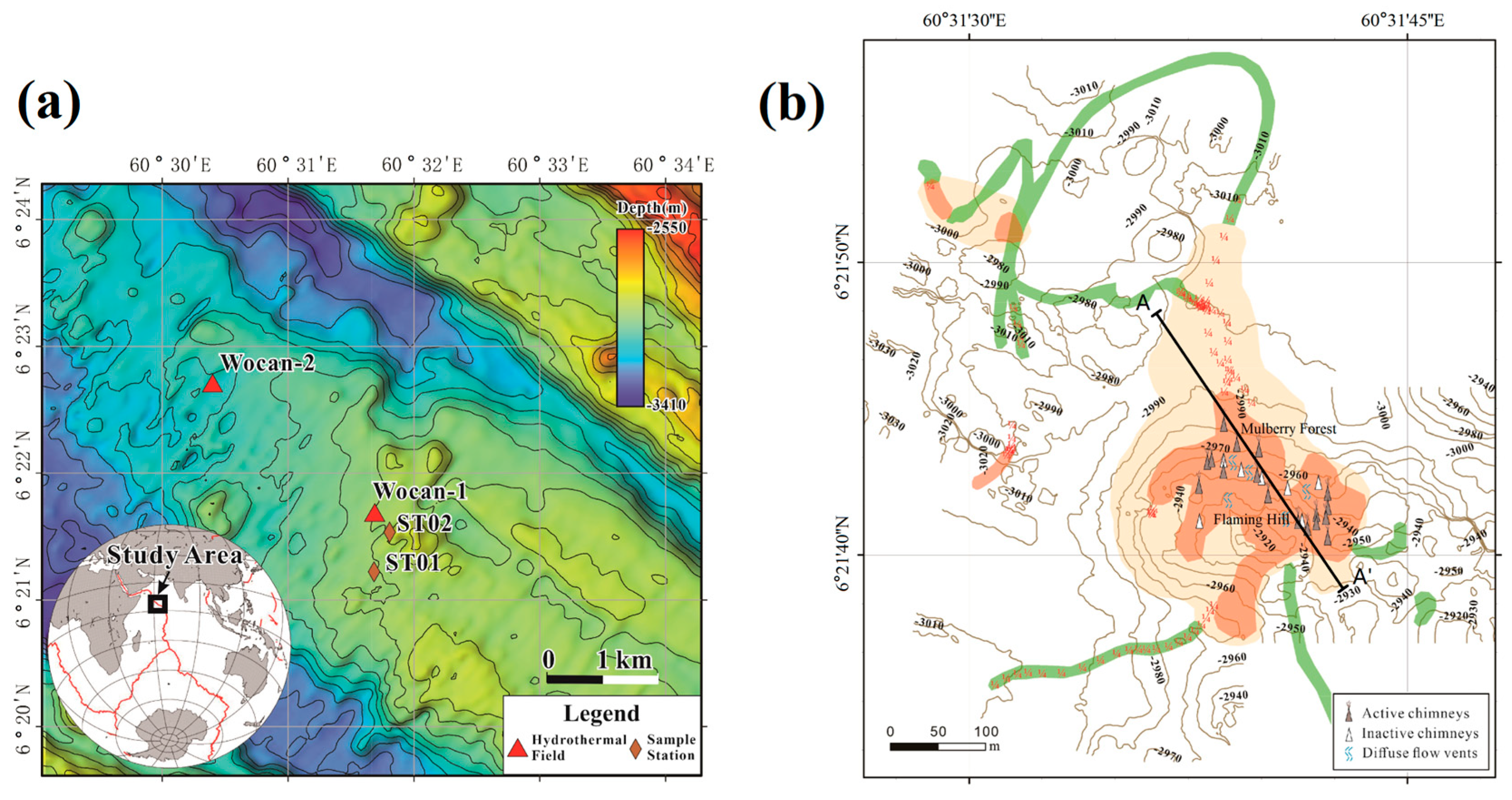
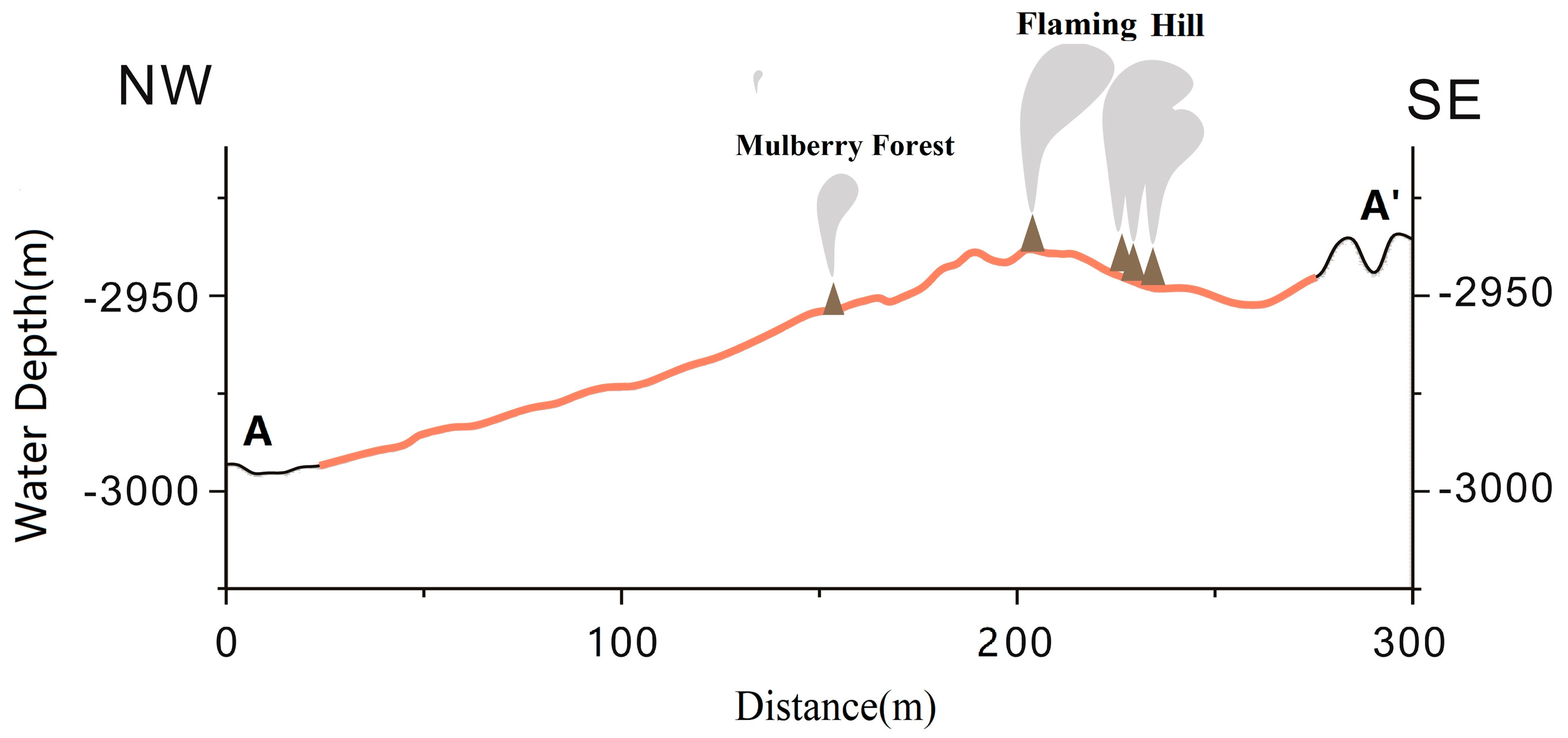

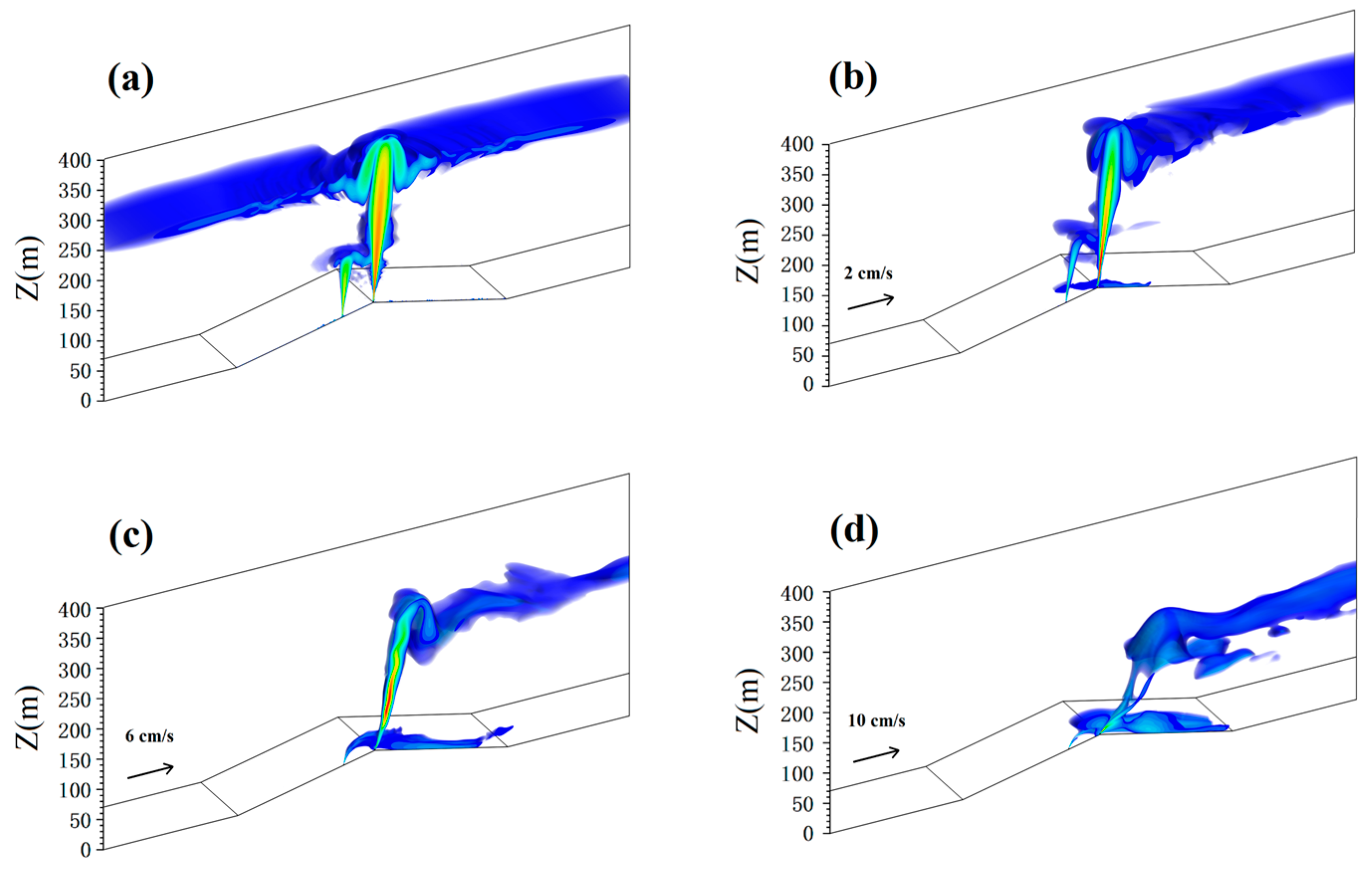
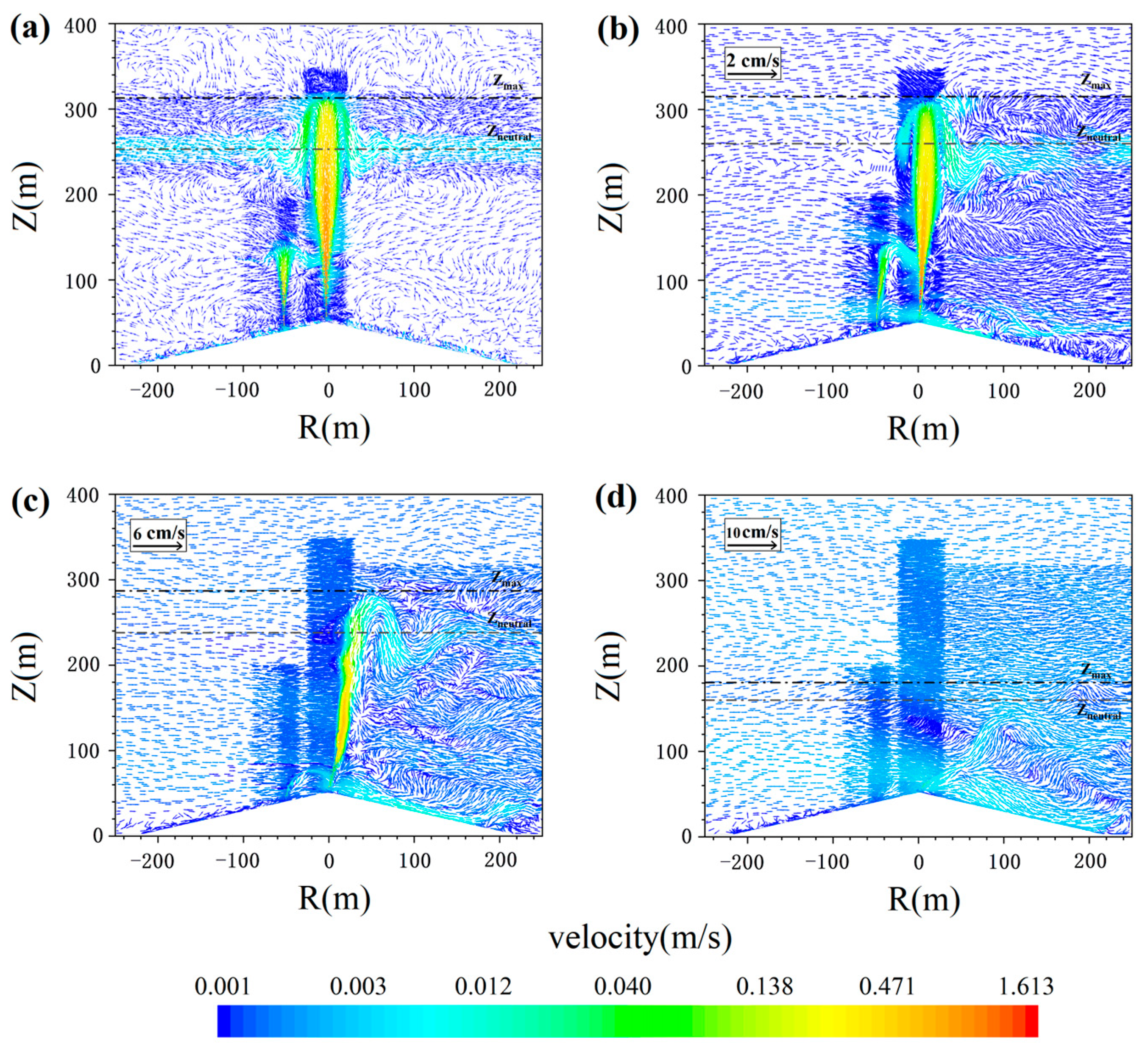
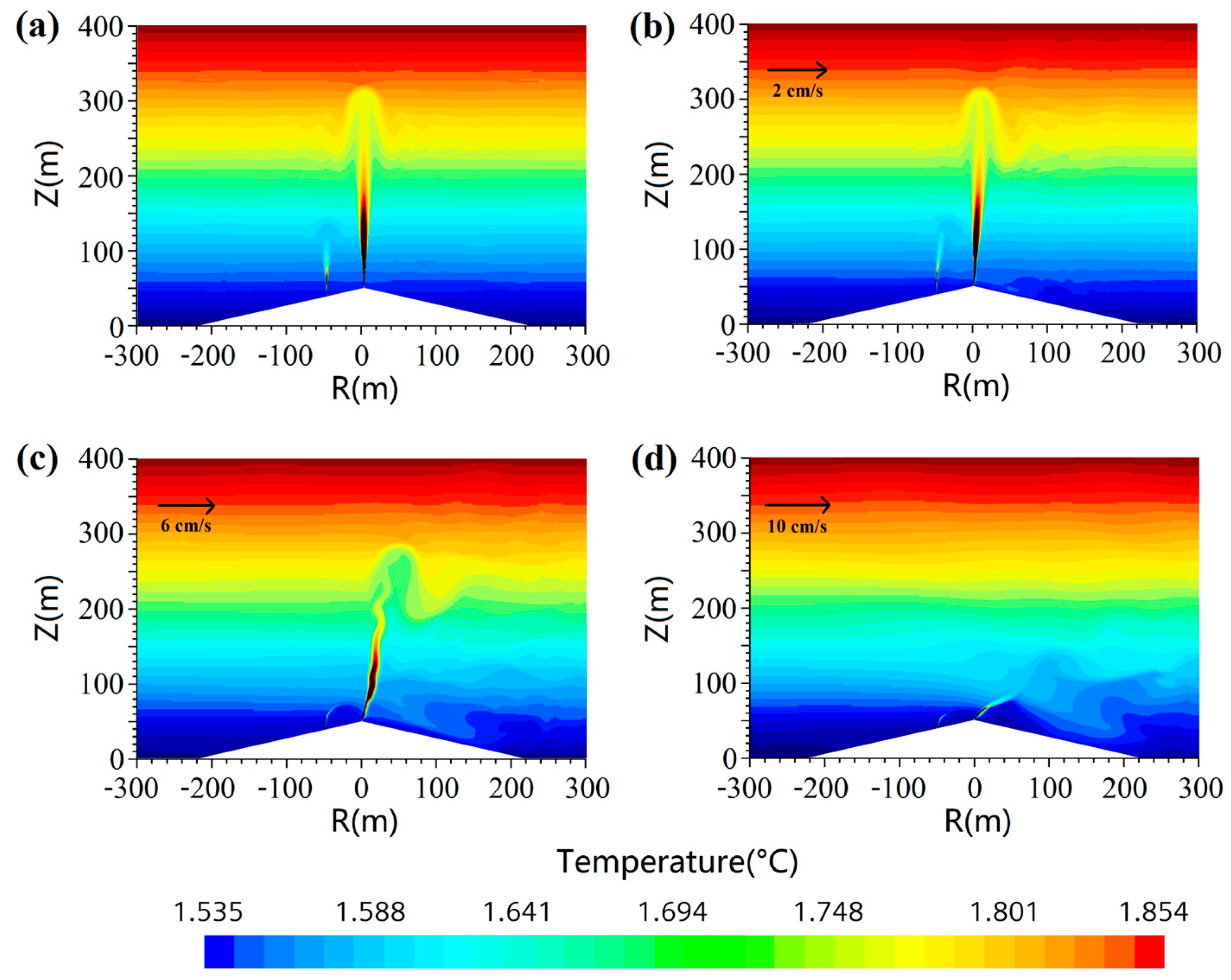

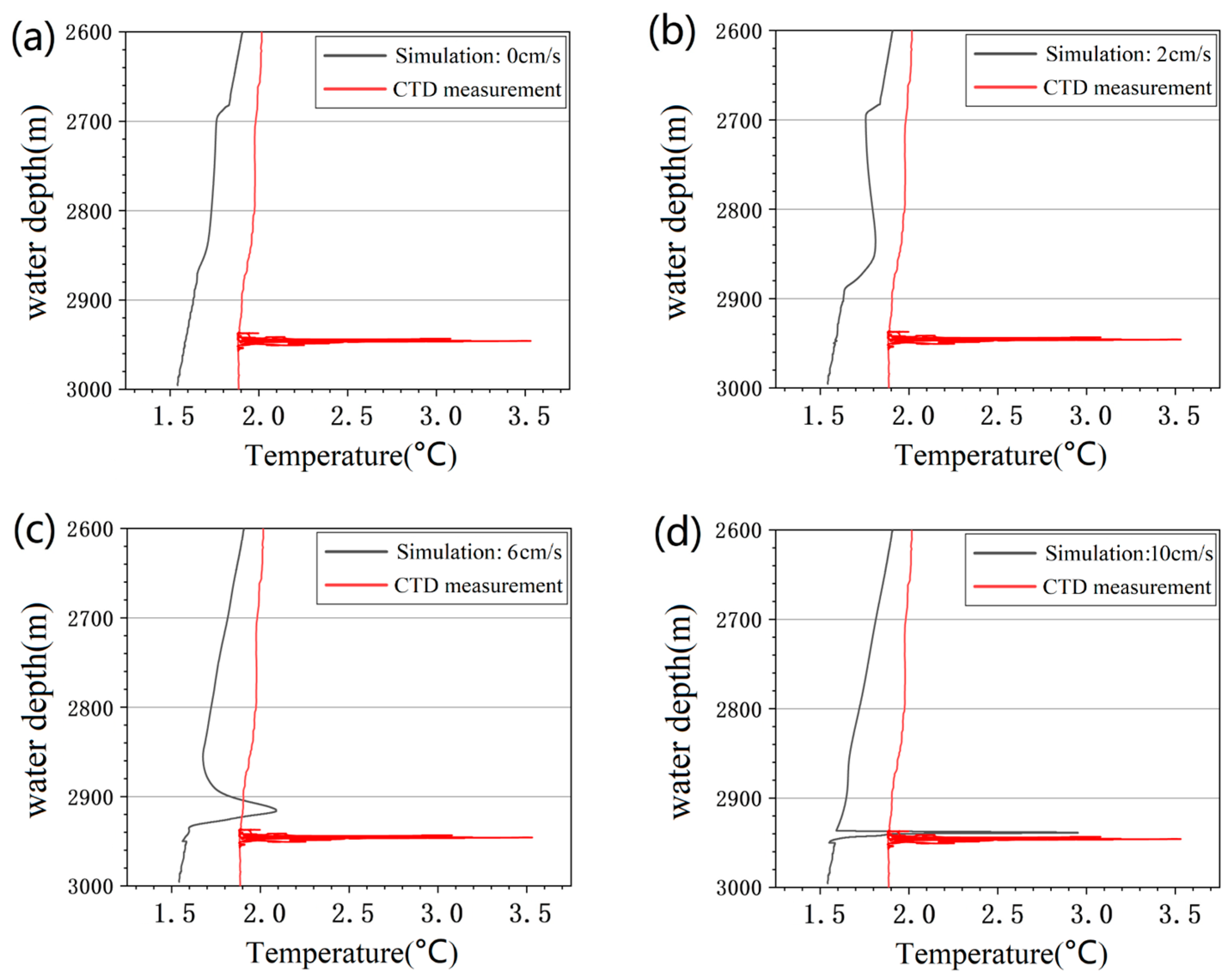
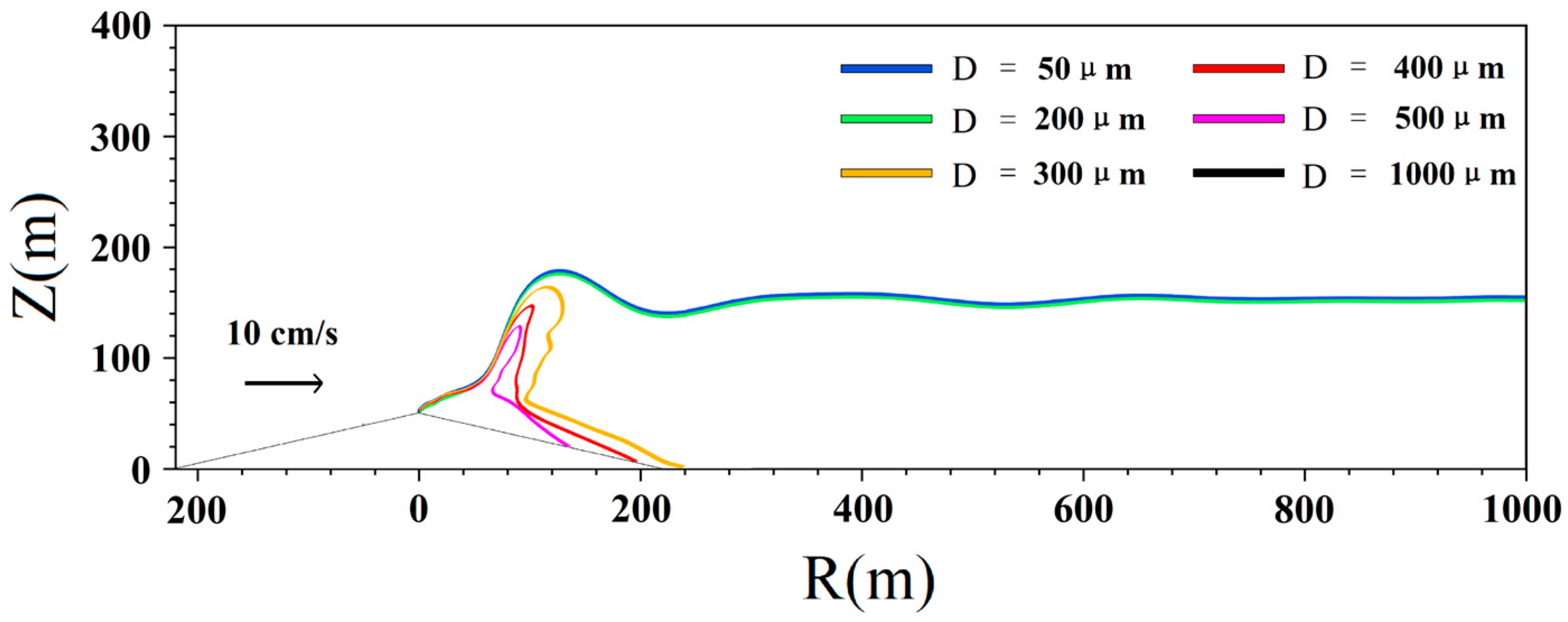
| Type | Parameter | Setting |
|---|---|---|
| computational domain | length | 2000 m |
| width | 200 m | |
| height | 400 m | |
| background | temperature gradient | 0.0093 °C/m |
| density gradient | 0.00463 kg/m4 | |
| background current direction | NW-SE | |
| background current velocity | 2~10 cm/s | |
| boundary condition | bottom | wall |
| top | pressure outlet | |
| side | symmetry plane | |
| vent | velocity inlet |
| Venting Area | Texit/°C | Tbottom/°C | Ttop/°C | R/m | v/(cm·s−1) |
|---|---|---|---|---|---|
| Flaming Hill | 360 | 1.535 | 1.907 | 0.4 | 20 |
| Mulberry Forest | 250 | 1.535 | 1.907 | 0.1 | 15 |
Disclaimer/Publisher’s Note: The statements, opinions and data contained in all publications are solely those of the individual author(s) and contributor(s) and not of MDPI and/or the editor(s). MDPI and/or the editor(s) disclaim responsibility for any injury to people or property resulting from any ideas, methods, instructions or products referred to in the content. |
© 2023 by the authors. Licensee MDPI, Basel, Switzerland. This article is an open access article distributed under the terms and conditions of the Creative Commons Attribution (CC BY) license (https://creativecommons.org/licenses/by/4.0/).
Share and Cite
Wang, K.; Han, X.; Wang, Y.; Cai, Y.; Qiu, Z.; Zheng, X. Numerical Simulation-Based Analysis of Seafloor Hydrothermal Plumes: A Case Study of the Wocan-1 Hydrothermal Field, Carlsberg Ridge, Northwest Indian Ocean. J. Mar. Sci. Eng. 2023, 11, 1070. https://doi.org/10.3390/jmse11051070
Wang K, Han X, Wang Y, Cai Y, Qiu Z, Zheng X. Numerical Simulation-Based Analysis of Seafloor Hydrothermal Plumes: A Case Study of the Wocan-1 Hydrothermal Field, Carlsberg Ridge, Northwest Indian Ocean. Journal of Marine Science and Engineering. 2023; 11(5):1070. https://doi.org/10.3390/jmse11051070
Chicago/Turabian StyleWang, Kanghao, Xiqiu Han, Yejian Wang, Yiyang Cai, Zhongyan Qiu, and Xiaoquan Zheng. 2023. "Numerical Simulation-Based Analysis of Seafloor Hydrothermal Plumes: A Case Study of the Wocan-1 Hydrothermal Field, Carlsberg Ridge, Northwest Indian Ocean" Journal of Marine Science and Engineering 11, no. 5: 1070. https://doi.org/10.3390/jmse11051070
APA StyleWang, K., Han, X., Wang, Y., Cai, Y., Qiu, Z., & Zheng, X. (2023). Numerical Simulation-Based Analysis of Seafloor Hydrothermal Plumes: A Case Study of the Wocan-1 Hydrothermal Field, Carlsberg Ridge, Northwest Indian Ocean. Journal of Marine Science and Engineering, 11(5), 1070. https://doi.org/10.3390/jmse11051070








